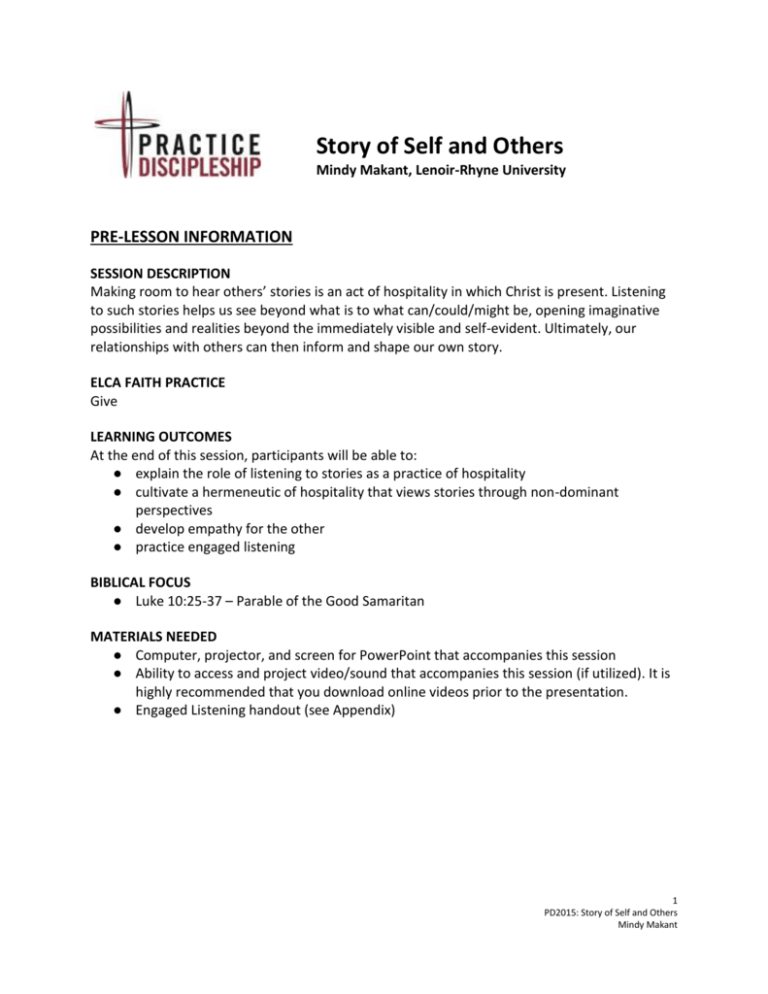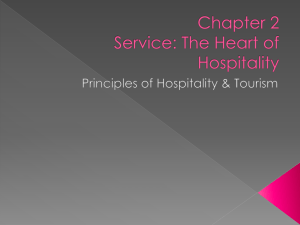5 Story of Self and Others
advertisement

Story of Self and Others Mindy Makant, Lenoir-Rhyne University PRE-LESSON INFORMATION SESSION DESCRIPTION Making room to hear others’ stories is an act of hospitality in which Christ is present. Listening to such stories helps us see beyond what is to what can/could/might be, opening imaginative possibilities and realities beyond the immediately visible and self-evident. Ultimately, our relationships with others can then inform and shape our own story. ELCA FAITH PRACTICE Give LEARNING OUTCOMES At the end of this session, participants will be able to: ● explain the role of listening to stories as a practice of hospitality ● cultivate a hermeneutic of hospitality that views stories through non-dominant perspectives ● develop empathy for the other ● practice engaged listening BIBLICAL FOCUS ● Luke 10:25-37 – Parable of the Good Samaritan MATERIALS NEEDED ● Computer, projector, and screen for PowerPoint that accompanies this session ● Ability to access and project video/sound that accompanies this session (if utilized). It is highly recommended that you download online videos prior to the presentation. ● Engaged Listening handout (see Appendix) 1 PD2015: Story of Self and Others Mindy Makant LESSON PLAN INTRODUCTION (slide 1) We are our stories. Who we are cannot be summarized by facts about us, but is a complicated mess of our stories and the stories of others whose lives intersect with ours. To know me is to know my story. Quick example – Describe yourself to the participants – begin with a physical description – height, build, gender, hair color, etc. Then ask the participants if they know you. Point out the being able to recognize you is different from knowing you. Then, tell them a short story about yourself, something that will reveal some aspect of your character or personality. Now ask again – do you know me? Of course the answer is, maybe a little bit. The point is the more stories you know the more you come to know another person. In this lesson we are going to think about the importance of stories and of ways we can be genuinely open to the stories of others, even stories we may find odd, or scary, or distasteful. Because sharing stories is one of the most important ways we have of demonstrating love for our neighbors. MINI-LECTURE (slides 2-5) Slide 2: Icon of the Hospitality of Abraham This icon is called “the Hospitality of Abraham.” It offers us an image of the three visitors who come to Abraham and announce to him that his wife will bear a child. If you recall the Genesis account, it is a story of hospitality, of Abraham and Sarah providing a meal and a place of respite for strangers, for travels. Of course, we learn that these aren’t just any visitors; this is, indeed, a divine visitation. Thus, this same icon is often said to represent the Holy Trinity. In providing hospitality to their visitors – in breaking bread together and in listening to their story – Abraham and Sarah provided hospitality not merely to strangers but to God. Hospitality is all about making room for the other, making a space which is not merely safe, but comfortable, home-like. Creating space for listening to another’s story is at the heart of the question of hospitality. In making space for someone’s story we are not merely making space for someone’s body, but for their very selves. In a somewhat different context, Miguel De La Torre (liberation theologian and ethicist) has pointed out that hospitality assumes it is our house. For the church, of course, we know this is not true – it is not our house. The hospitality we extend to the others in listening to their stories is one of the ways we participate in God’s ultimate act of hospitality in which all of our stories are being woven together in God’s story. 2 PD2015: Story of Self and Others Mindy Makant Slide 3: Hermeneutics of Hospitality To share your story is to share yourself; to receive a story is to receive another. In sharing stories you give a piece of yourself; stories are more than an exchange of information as if our stories are a good or service. Stories bind us to one another, intersecting our lives in interesting and formative ways. Developing the skills necessary to become a people who are open to the stories of the other –whether that other is the religious, social, racial, gender, etc. – is a faith practice, a practice in which we both give the gift of ourselves and receive the gift of the other. Stories provide us with a new lens with which to see the world around us. Stories invite us to walk in the shoes of diverse people whose experiences may be vastly different from ours. These stories help us see not merely what is but what can/could/might be. Stories open us up to imaginative possibilities, to realities beyond the immediately visible and self-evident. When I open myself to listen, really listen, to the story of another, I risk being radically changed, of seeing the world in radically new ways. RESPONSE ACTIVITY (slide 4) Let’s look at an example, a story you all know: Just then a lawyer stood up to test Jesus. “Teacher,” he said, “what must I do to inherit eternal life?” He said to him, “What is written in the law? What do you read there?” He answered, “You shall love the Lord your God with all your heart, and with all your soul, and with all your strength, and with all your mind; and your neighbor as yourself.” And he said to him, “You have given the right answer; do this, and you will live.” But wanting to justify himself, he asked Jesus, “And who is my neighbor?” Jesus replied, “A man was going down from Jerusalem to Jericho, and fell into the hands of robbers, who stripped him, beat him, and went away, leaving him half dead. Now by chance a priest was going down that road; and when he saw him, he passed by on the other side. So likewise a Levite, when he came to the place and saw him, passed by on the other side. But a Samaritan while traveling came near him; and when he saw him, he was moved with pity. He went to him and bandaged his wounds, having poured oil and wine on them. Then he put him on his own animal, brought him to an inn, and took care of him. The next day he took out two denarii, gave them to the innkeeper, and said, ‘Take care of him; and when I come back, I will repay you whatever more you spend.’ Which of these three, do you think, was a neighbor to the man who fell into the hands of the robbers?” He said, “The one who showed him mercy.” Jesus said to him, “Go and do likewise.” American hearers of this story often presume the moral of this story is to be like the Good Samaritan. We know this story – Jesus wants us to be kind to those who are injured or poor or in need. We like this story, especially when we think it is about us. But such a presumption assumes a level of privilege and power that not everyone has. Let’s take a moment and imagine 3 PD2015: Story of Self and Others Mindy Makant the story from non-dominant perspectives. Imagine the story the injured man tells the next day. And what about the innkeeper? Divide participants in half. Ask each side of the room to work in groups of 3 or 4. Ask one half of the room to imagine the story from the perspective of the innkeeper and one half from the perspective of the injured man. How might they tell the story? Take power and privilege off the table – what if you’re the person who is beat up and left for dead? Or, what if you’re the person who is asked to care for another with a promise for payment – a promise you may not be inclined to trust? Then, what is important in this parable? Give groups 2-3 minutes. Come back together as a large group and discuss. Share highlights. How hard/easy is it to imagine the other person’s story? What would be most helpful? As important a skill as imaginative empathy is, seriously engaging another person’s story requires listening, giving them the space to share their story and receiving it as a gift. ENGAGED LISTENING ACTIVITY (slide 5) Hearing another person’s story requires listening. Hearing is one of our senses – it happens; but listening is an intention, it is something we have to actively do. Distribute the Engaged Listening handout and discuss it briefly, Have everyone think of a story of their childhood (or perhaps about celebrating Christmas or Easter or birthdays or another meaningful occasion). How does this story – and the memory of this story – shape the person you are today? Allow a minute or so for participants to think. Pair up and share stories. Allow each person 2 minutes to share. Return to the large group – Discuss, not the stories themselves, but the experience of sharing stories with another. Try to pull out that sharing stories creates community, is a way of loving our neighbor. CLOSING THE CONVERSATION Thank the group for their participation and make any final remarks or announcements. End with a closing prayer. 4 PD2015: Story of Self and Others Mindy Makant SUGGESTED RESOURCES The following are suggested as resources for further exploration of this session’s topic. Arthur, Sarah. The God-Hungry Imagination: The Art of Storytelling for Postmodern Youth Ministry. Nashville, TN: Upper Room Books, 2007. Bass, Dorothy C., and Don C. Richter. Way to Live: Christian Practices for Teens. Nashville, TN: Upper Room Books, 2002. (Leader’s guide available as free download at www.waytolive.org.) Keeley, Robert J., editor. Shaped by God: Twelve Essentials for Nurturing Faith in Children, Youth, and Adults. Grand Rapids, MI: Faith Alive Christian Resources, 2010. Rogers, Frank, Jr. Finding God in the Graffiti: Empowering Teenagers through Stories. Cleveland, OH: Pilgrim Press, 2011. AUTHOR BIOGRAPHY Mindy Makant is Assistant Professor of Religion Studies and coordinator of the Youth and Family Ministry program at Lenoir-Rhyne University in Hickory, N.C. She is author of the forthcoming The Practice of Story: Suffering and Possibilities of Redemption (Baylor University Press, 2015). This curriculum was developed for the Practice Discipleship Initiative. Practice Discipleship is a ministry of the ELCA Youth Ministry Network in close partnership with the ELCA and its synods. It is funded by the Congregational and Synodical Mission Unit of the ELCA as an extension of the ministry of the ELCA Youth Gathering. Permission is given to use these resources in your local context, so long as no organization or individual profits from the use of these materials. For more information please visit www.practicediscipleship.org. 5 PD2015: Story of Self and Others Mindy Makant Video Script – Story of Self and Others The following script is, generally speaking, the content contained in the video segment of this lesson, provided as information for those who cannot access or do not wish to utilize the video. Hospitality is all about making room for the other, making a space which is not merely safe, but comfortable, home-like. Creating space for listening to another’s story is at the heart of the Christian practice of hospitality. In making space for someone’s story we are not merely making space for someone’s body, but for their very selves. In a somewhat different context, Miguel De La Torre (liberation theologian and ethicist) has pointed out that hospitality assumes it is our house. For the church, of course, we know this is not true – it is not our house. Rather, the hospitality we extend to the others in listening to their stories is one of the ways we participate in God’s ultimate act of hospitality in which all of our stories are being woven together in God’s story. To share your story is to share yourself; to receive a story is to receive another. In sharing stories you give a piece of yourself; stories are more than an exchange of information as if our stories are a good or service. Stories bind us to one another, intersecting our lives in interesting and formative ways. Developing the skills necessary to become a people who are open to the stories of the other - whether that other is the religious, social, racial, gender, etc other – is a faith practice, a practice in which we bot give the gift of ourselves and receive the gift of the other. Stories provide us with a new lens with which to see the world around us. Stories invite us to walk in the shoes of diverse people whose experiences may be vastly different from ours. These stories help us see not merely what is but what can/could/might be. Stories open us up to imaginative possibilities, to realities beyond the immediately visible and self-evident. When I open myself to listen, really listen, to the story of another, I risk being radically changed, of seeing the world in radically new ways. Jesus parables offer a scriptural example of this. For example, the story of the Prodigal Son is a story that can open the hearer to a broader understanding of both self and community: Then Jesus said, “There was a man who had two sons. The younger of them said to his father, ‘Father, give me the share of the property that will belong to me.’ So he divided his property between them. A few days later the younger son gathered all he had and traveled to a distant country, and there he squandered his property in dissolute living. When he had spent everything, a severe famine took place throughout that country, and he began to be in need. So he went and hired himself out to one of the citizens of that country, who sent him to his fields to feed the pigs. He would gladly have filled himself with the pods that the pigs were eating; and no one gave him anything. But when he came to himself he said, ‘How many of my father’s hired hands have bread enough and to spare, but here I am dying of hunger! I will get up and go to my father, and I will say to him, “Father, I have sinned against heaven and before you; I am no longer worthy to be called your son; treat me like one of your hired hands.”’ So he set 6 PD2015: Story of Self and Others Mindy Makant off and went to his father. But while he was still far off, his father saw him and was filled with compassion; he ran and put his arms around him and kissed him. Then the son said to him, ‘Father, I have sinned against heaven and before you; I am no longer worthy to be called your son.’ But the father said to his slaves, ‘Quickly, bring out a robe—the best one—and put it on him; put a ring on his finger and sandals on his feet. And get the fatted calf and kill it, and let us eat and celebrate; for this son of mine was dead and is alive again; he was lost and is found!’ And they began to celebrate. So, why was the boy hungry? Why did he return home? In his book, What Do They Hear?, New Testament professor Mark Allan Powell recounts his experiences with teaching this parable to seminarians. He reports that 100% of American seminary students answer that he is hungry because he has squandered his money and 6% also mention that there was a famine in the land. When has asked the same question to seminarians in St. Petersburg Russia the vast majority of the students say he was hungry because there was a famine. Why is this? The Russian students pointed out that squandering money is irrelevant – in a famine everyone is hungry. Powell also asked seminarians in Tanzania the same question and got yet a different answer – the boy was hungry because no one would give him anything to eat. For a young man to squander his money while in a foreign land did not bother the Tanzanians – he was a young man, young men do stupid things, we don’t let the starve on account of it! – the problem is the community failed to care for the stranger in its midst. You may recall this from Carol Jacobsen’s lesson. Carol was helping us learn to recognize the reality of differences due to social location. I want us to now think about why and how these differences might matter. In other words, where someone comes from, the life stories they bring to the Scriptures, has a significant impact on how they hear – and thus how they tell – the stories of Scripture. Opening ourselves to the stories of others – including their interpretation of the stories of Scripture – can invite us into non-dominant perspectives and allow us to view not only the world, but the Word of God, through a set of lenses we would not otherwise have access to. 7 PD2015: Story of Self and Others Mindy Makant Engaged Listening Silence – Stop talking. This seems obvious, but we cannot really listen to another if we are talking. Eye contact – Making appropriate eye contact demonstrates concern and interest. Overly aggressive eye contact, however, can be intimidating. Respond to the non-verbal cues of the speaker. Observe body language – Is the speaker anxious, excited, sad, joyful, etc. Encouragement – Offer encouragement for the speaker to continue his/her story by nodding and making non-judgmental sounds of affirmation. Patience – Allow for silence, give the speaker time to gather his/her thoughts and to craft the story as they speak. Probe – Ask open-ended questions to encourage further narrative, not for the sake of criticizing or judging. Clarify – Check for understanding. If something is unclear, ask. Empathize – Imagine how the speaker feels, but don’t assume you know how the speaker feels. Habits to avoid: ● Interrupting ● Assuming you know the story ● Assuming you understand how the other person feels ● Making moral judgments ● Becoming impatient, angry, or anxious if the other person’s story is not what you expect ● Making the story about you ● Planning you response while the speaker is still talking







